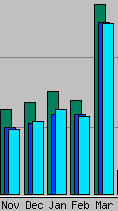Lake Tahoe, CA/NV…Fall is underway in the Tahoe Basin and Lake Tahoe bears are hungry! Autumn is the time of year when bears enter hyperphagia, a phase they go through when they seek massive amounts of calories before entering their winter dens. It’s important that residents and visitors are aware of this heightened bear activity and that they take steps to prevent bears from accessing human food and garbage.
Members of the Tahoe Interagency Bear Team recently attended the 6th International Human-Bear Conflicts Workshop in South Lake Tahoe to discuss and learn about all aspects of human-bear interaction and how we can best share the landscape.
“Hyperphagia is in full swing,” said California Department of Fish and Wildlife Biologist, Sara Holm. “Many bears were seen by workshop attendees scavenging food from unsecured trash containers. It’s disappointing how easy people are still making it for these bears to access the wrong kind of calories.”
Bears Prepare for Hibernation
During fall, bears are very active as they hunt for fish, seeds, berries, grubs, and other high-protein natural foods. Human food should not fall into this category. Learn more by watching and sharing the following YouTube video: https://youtu.be/SeL1U67XNdY.
Wild black bears normally eat around 5,000 calories a day during the year, but in the fall, they need an average of 20,000 calories a day to store as fat over the winter. Bears in the Tahoe Basin tend to consume more than they need by eating unhealthy human foods as well as staying more active over the winter months to try and take advantage of human food sources.
Hibernation, or torpor as it’s more accurately referred to for bears, occurs in late fall or early winter as the weather cools and natural food becomes less available. This slows down a bear’s metabolism and allows them to reduce activity in their dens and live off their fat stores.
Habituated bears, males in particular, will often leave the den during this time to seek out easily obtainable food. Females, which will give birth at the beginning of the year, are more likely to stay in their dens. This could explain why Lake Tahoe residents still see some bear activity in the winter.
No Handouts!
During hyperphagia, bears can be very focused and persistent about getting food. They often spend most of the day trying to eat which makes them more vulnerable to vehicle strikes and interaction with people. Do not try to defend a food source from a hungry bear. Do make sure to keep using and locking dumpsters and bear-resistant trash containers. Pack out trash that doesn’t fit into full containers whether you’re at a rental, the beach, or a trailhead. Never provide food for bears. It’s illegal, unhealthy, and can lead to human-bear conflicts such as home/vehicle break-ins or physical contact. Let bears find food in the wild and give them space.
Bear Managers at Work
Bear managers and law enforcement officers may be out hazing bears. If you see these officials yelling at bears, using air horns, or chasing them, it’s to try and get these bears out of populated areas or to give them a negative experience with humans instead of a food reward.
Officers may fire non-lethal bean bag rounds when it is determined safe to do so. This may temporarily deter bears or force them to leave the area and while it may sting, it’s not meant to cause injury. Bears often climb trees to escape danger. This is the time to back off, get somewhere safe and let them come down on their own. Hazing bears that are up in trees won’t work and sends a mixed message to the bear. Officials do their best to keep people and bears safe.
Living and recreating in the Tahoe Basin’s bear country is a year-round responsibility. Please do your part to help us keep Tahoe bears wild! Here are some helpful tips to follow:
Never feed wildlife. Feeding wildlife often brings animals in conflict with people and attracts wildlife to human homes and neighborhoods where they can get struck by vehicles and encounter other human hazards.
Store all garbage in and properly close bear-resistant garbage containers, preferably bear boxes. Inquire with local refuse companies about new bear box incentives and payment programs. In California, visit the South Tahoe Refuse Bear Information website. In Nevada, residents should check the Nevada Department of Wildlife’s website: Living with Bears.
Never leave groceries, animal feed, garbage, or anything scented in vehicles, campsites, or tents.
Be sure to always lock vehicles and close the windows. Understand that eating – even drinking coffee – in your car often leaves lingering odors that attract bears.
Keep barbecue grills clean and stored in a garage or shed when not in use.
Keep doors and windows closed and locked when the home is unoccupied.
Vegetable gardens, compost piles, fruit trees, and chickens may attract bears. Use electric fences where allowed to keep bears out. Refrain from hanging bird feeders.
When camping, always store food (including pet food), drinks, toiletries, coolers, cleaned grills, cleaned dishes, cleaning products, and all other scented items in the bear-resistant containers (storage lockers/bear boxes) provided at campsites. Bear-resistant coolers that come equipped with padlock devices should always be locked to meet bear-resistant requirements.
Always place garbage in bear-resistant dumpsters in campgrounds or in bear-resistant containers at campsites (storage lockers/bear boxes) and close and lock after each use.
Store food in bear-resistant, hard-sided food storage canisters while recreating in the backcountry.
Give wildlife space. Enjoy wildlife from a distance, especially when they have young with them.
Leave small bears alone, mom might be right around the corner.
Secure crawl spaces and winterize your home, including removal of all food when unoccupied.
To report human-bear conflicts in California, contact the California Department of Fish and Wildlife (CDFW) at 916-358-2917 or report online using CDFW’s Wildlife Incident Reporting (WIR) system at https://apps.wildlife.ca.gov/wir. Non-emergency wildlife interactions within California State Parks can be reported to public dispatch at 916-358-1300. To report human-bear conflicts in Nevada, contact the Nevada Department of Wildlife (NDOW) at 775-688-BEAR (2327). If the issue is a direct threat or emergency call 911 to seek immediate help from local law enforcement.
For more information on peacefully coexisting with Lake Tahoe bears, visit TahoeBears.org.
###



